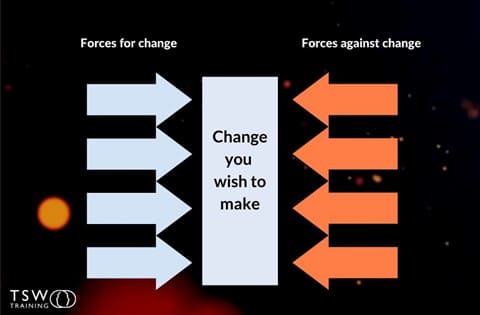The ‘Force Field Analysis model’ can help you to weigh up the pros and cons of implementing change, and help you make the right decision for you and your team.
Making changes within a business is never straight-forward as there are so many factors to think about, not least the impact on your team. Here we explain how leaders can use the Force Field Analysis method to help choose to right course of action.
- The Force Field Analysis method helps leaders understand both sides of a situation, and decide whether you can achieve the right outcome for your team.
- Firstly, you’ll outline your driving forces and give them a score between 1 and 5, where 1 is less important and 5 is most important. Then, you’ll do the same for your opposing forces – the things working against your idea for change.
- With the scores added up, leaders are then able to clearly see the positives and negatives of a given situation, allowing them to make better decisions that benefit the business.
What Is Force Field Analysis?
The Force Field Analysis was created by Kurt Lewin in the 1940s. An American social psychologist, Lewin specialised in change management and group dynamics.
In his published works, Lewin spoke about the state of equilibrium and the forces on both sides of change. In order for change to happen, the driving forces need to overcome the opposing forces.
The Force Field Analysis helps you to understand both sides of the situation, and whether you can achieve the outcome you desire. You can either reduce the forces working against you or strengthen the driving forces to bring about the change you wish to see.
How To Use The Force Field Analysis

Force Field Analysis: Analysing the pressures for and against change
Firstly, you’ll need to think about what you want your desired outcome to be. For example, a manufacturing company might want to ensure their team are working to lean principles while they’re in the factory. Once you have your desired state, this goes in the middle of your Force Field Analysis as the key focus.
Next, you’ll think about the driving forces that are working in favour of this. If we’re thinking about our manufacturing company, that might be:
- Having state-of-the-art equipment that allows the team to work efficiently
- The cost of savings you could make by introducing lean principles
- Willingness of staff to learn new skills
When you’ve outlined your driving forces, you’ll need to give them a score between 1 and 5, where 1 is less important and 5 is most important.
Then, you’ll do the same for your opposing forces – the things working against your idea for change. That could be:
- Resistance to change from leadership team who have been in place for decades
- Workplace culture of each person specialising in one task
- Public opinion and impact on the community if redundancies are made
You’ll do the same for these forces, scoring them between 1-5.
Finally, you’ll add up your scores on the driving forces side and the opposing forces side. You might find that the positives vastly outweigh the negatives and change will be easier. Or the opposing forces could be particularly important, and change will be more difficult.
Now that you have it all laid out in front of you, you can work out a plan. Can you see ways to strengthen the positive forces in favour of change, or methods of minimising the opposing forces?
Why do some leaders struggle with decision making?
Decision-making isn’t always easy, especially when you’re making them on behalf of the entire business.
Not having a true understanding of business priorities can make it tricky to know where your focus should be, and a busy leader might not have time to work out a clear strategy and direction for the company.
If a leader has a lack of trust in the team surrounding them, it can make decision making more difficult as they won’t be able to put their faith in the opinions of those they work closely with.
Another reason a leader might find decision making difficult is there may be too much bias within the business already, pushing them towards a direction they may not want to take.
Why is it important for leaders to make good decisions?
The strength of a leader lies in their ability to make good decisions. It’s important for them to ensure the prosperity of the business and further its success.
Leaders can also inspire their workforce through the decisions they make and improve trust within the leadership team.
How can leaders use this model to improve their decision-making and become a better leader?
Using the Force Field Analysis model, leaders are able to clearly see the positives and negatives of a given situation, allowing them to make decisions that benefit the business. The holistic view that the model offers can help them to see what they need to focus on.
Leaders can also immediately see the pros and cons of change from the Force Field Analysis model and decide whether they should take the risk.
Having a greater understanding of emotional intelligence can help leaders to understand the people in their business, which they can factor in when they’re making big decisions.
What impact can the Force Field Analysis have on your team and business goals?
It can help you move closer to your business goals by assessing the route you want to take and weighing up the positives and negatives of the situation. Alternatively, it can help you change direction completely if you think it’s worth it from your analysis.
The outcome is more than likely going to affect the team and may impact their roles within the business. You’ll have to weigh up what their reaction will be when you’re thinking about implementing the changes.
Are there any disadvantages to the Force Field Analysis model?
Some disadvantages have been put forward for this particular model, which include:
- It can be too simplistic, and you may need to use other models to put a full strategy together
- Giving scores to different forces is completely subjective, and may differ from person to person
- It may not be useful for every setting
- You may need to get input from lots of people around the business which can take time
More tools to improve your decision-making as a leader
- Six Thinking Hats – this is an exercise that helps you analyse decisions in various ways, but focussing on one way at a time. Adopting this tool can help you understand various aspects of the situation and is a great way to get your team involved in the decision-making process.
- Force Field Analysis – this tool can help you weigh up the pros and cons to help you figure out the most suitable choice.
- Personal Ansoff Matrix: this tool helps you assess the risks of choosing a particular option for your personal development.







